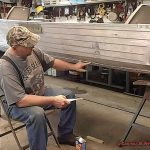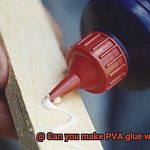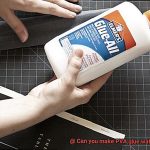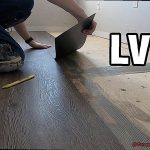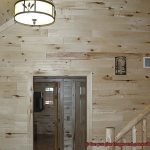Woodworking is a captivating art form that requires immense skill, patience, and attention to detail. As a beginner in the field, you may have wondered whether it’s possible to join wood with just glue instead of relying on nails or screws. It’s a question that can spark heated debates among woodworkers.
But fear not. The answer is a resounding YES. Using glue as the primary joining material for wood is not only possible but also cost-effective and efficient. However, don’t be fooled into thinking that any old glue will do the job. The glue you choose must be strong enough to hold two pieces of wood together without any additional support from nails or screws. It should also be able to withstand the pressure that the wood will face over time.
In this blog post, we’ll delve into the various types of glue available and help you select the right one for your project. We’ll provide essential tips on how to make the most out of your chosen glue and create a joint that stands the test of time. So buckle up and get ready for an informative journey on how you can join wood with just glue.
What is Glue?
Contents
- 1 What is Glue?
- 2 Types of Glue for Woodworking
- 3 Factors to Consider When Joining Wood with Glue
- 4 Different Types of Wood and How They Bond With Glue
- 5 The Need for Pressure and Time When Joining Wood with Glue
- 6 Tips for Joining Wood with Just Glue
- 7 Common Mistakes to Avoid When Joining Wood with Just Glue
- 8 Conclusion
Glue may seem like a simple substance, but it is actually a crucial tool in the world of woodworking. At its core, glue is a substance that can be used to join two or more surfaces together. However, the type of glue used and the techniques employed can make all the difference in creating a strong and secure bond.
The most commonly used glue for woodworking is PVA glue, also known as white glue or carpenter’s glue. This water-based adhesive is affordable, readily available, and creates a strong bond when used properly. But PVA glue is just one of several types of glue that can be used for woodworking. Other options include epoxy, cyanoacrylate (super glue), and polyurethane.
When choosing a type of glue for a woodworking project, it’s important to consider several factors. The type of wood being used can impact how well it bonds with certain types of glue. Some woods are more porous than others, which can affect the strength of the bond. Additionally, the grain and texture of the wood can play a role in how well it bonds with glue.
Creating a strong bond with glue also requires proper pressure and time. Simply applying glue and pressing the pieces together may not be enough to create a solid joint. In many cases, clamps or other tools may be necessary to hold the pieces together while the glue dries.
It’s also important to use the right amount of glue for the job at hand. Using too much or too little can affect the strength of the bond and cause problems down the line. Carefully following the manufacturer’s instructions is crucial for achieving a successful woodworking project.
Types of Glue for Woodworking
When it comes to woodworking, selecting the right type of glue is just as crucial as choosing the right type of wood. There are various types of glue available in the market, each with its unique properties and applications. Let’s delve into the different types of glue available for woodworking and their distinctive features and uses.
PVA or White Glue
Polyvinyl Acetate or PVA glue is a versatile and popular adhesive used for woodworking. It is known for its strong bonding capabilities and dries clear, making it ideal for use on natural wood surfaces. PVA glue is easy to clean up with water and is perfect for indoor projects. Additionally, it’s relatively inexpensive compared to other types of glue, making it an excellent option for budget-conscious woodworkers.
Hide Glue
Hide glue has been used for centuries in woodworking and is made from animal hide and bones. It has a long open time, which means that it remains workable for an extended period, giving woodworkers more time to make adjustments before the glue sets. Hide glue is also reversible, making it easy to repair damaged joints. This type of glue is perfect for traditional woodworking projects or antique restoration work.
Epoxy Glue
Epoxy is a two-part adhesive that creates a remarkably strong bond. It is waterproof, heat resistant, and can be sanded and painted over once dry. Epoxy is best suited for outdoor projects or items that will be exposed to moisture or high temperatures. However, it requires mixing before use and has a relatively short working time. Woodworkers must work quickly after mixing the epoxy to ensure that it does not harden before application.
Cyanoacrylate or Super Glue
Super glue is a fast-drying adhesive that forms an almost instant bond. It’s ideal for small projects or repairs but not recommended for larger woodworking projects as it does not have the same strength as other types of glue. It’s also important to note that super glue can be challenging to remove once it’s been applied, so it’s crucial to use it sparingly.
Polyurethane Glue
Polyurethane glue is known for its strength and durability. It expands as it dries, filling gaps in joints, making it ideal for use in uneven surfaces or rough cuts. However, polyurethane glue requires moisture to cure properly, so it’s essential to dampen surfaces before application. It’s a great option for projects that require a strong bond and can withstand heavy loads.
Factors to Consider When Joining Wood with Glue
Woodworking is an art that requires precision, patience, and attention to detail. One of the most critical aspects of woodworking is joining pieces of wood together, and glue is often the go-to method for many woodworkers. However, there are several factors to consider when selecting the right glue for your project to ensure a strong and durable bond.
Firstly, it’s crucial to choose the right type of glue for your job. There are several types of wood glue available on the market, such as PVA, epoxy, cyanoacrylate, and polyurethane. Each type has unique properties that make them suitable for specific woodworking projects.
For instance, PVA glue is ideal for general woodworking projects as it dries clear and is easy to sand. Epoxy glue is incredibly strong and can be used for heavy-duty applications. If you’re restoring antiques, hide glue is the way to go. Knowing the properties of each type of glue will help you choose the right one for your project.
Secondly, the condition of the wood being joined plays a pivotal role in creating a strong bond. The wood must be clean, dry, and free from any dust or debris that could prevent the glue from bonding correctly. If the wood is too wet or too dry, it can also affect the strength of the joint. Allowing the wood to acclimate to its surroundings before gluing ensures that it has reached the correct moisture level.
Lastly, how you apply the glue matters significantly. The glue should be applied evenly and generously to both surfaces being joined. Using clamps or weights to hold the joint together while the glue dries is essential. This can take anywhere from a few hours to overnight depending on the type of glue used. Without proper clamping pressure, air pockets may form in between the pieces of wood, resulting in a weak bond.
Different Types of Wood and How They Bond With Glue
Joining pieces of wood together with just glue can be a challenging task, but understanding the properties of different types of wood and the appropriate glue to use can make all the difference.
Softwoods, such as pine and spruce, are known for their open grain and porous nature, which makes them easy to bond with glue. However, the glue can seep into the wood, weakening the joint.
To combat this issue, thick or slow-drying glue is recommended to give the wood enough time to absorb it before it sets.
Hardwoods, like oak and maple, have a tighter grain than softwoods which makes them more challenging to bond with glue. To ensure a strong bond on hardwoods, it’s important to use a thin or fast-drying glue that can penetrate the tight grain before it sets.
Exotic woods, such as teak and mahogany, have oils and resins that interfere with the adhesive’s ability to penetrate the wood and create a strong bond. A specialized adhesive designed specifically for exotic woods is required to overcome this challenge.
PVA (polyvinyl acetate) glue is a popular choice for woodworking as it dries clear and is easy to clean up while still wet. It creates a strong bond on most types of wood. Epoxy is a two-part adhesive that creates an incredibly strong bond and is waterproof. Cyanoacrylate (super glue) is not recommended for use on large surfaces or joints but can be useful for small repairs or bonding small pieces of wood together.
The Need for Pressure and Time When Joining Wood with Glue
For a strong and durable bond, you need to apply pressure and allow sufficient time for the glue to set.
Let’s start with pressure. When you apply enough pressure to the glued surfaces, the glue spreads evenly and fills any gaps or voids between the two pieces of wood. This creates a bond that can withstand the test of time. However, without enough pressure, the bond may be weak and prone to failure. To ensure that enough pressure is applied, clamps or other pressure tools are often used when joining wood with glue.
Now, let’s talk about time. The glue needs sufficient time to dry and cure before it can create a strong bond. The exact amount of time required depends on the type of glue used. Rushing the process by removing the clamps too soon or using the wood before the glue has fully cured can result in a weak bond that may eventually fail. So, be patient. Allow enough time for the glue to dry and cure properly before using the joined pieces of wood.
It’s worth noting that certain types of wood may not be suitable for glue bonding due to high oil content. Woods such as teak or cedar can make it difficult for glue to adhere properly. If this is the case, other joining methods may need to be explored.
Tips for Joining Wood with Just Glue
Joining wood with glue can be a great alternative to unsightly nails or screws. However, it requires careful preparation and execution to ensure a strong bond. Here are some tips for creating a durable bond between pieces of wood using just glue.
Choose the right type of glue
Not all glues are created equal. For woodworking, PVA and epoxy are the most commonly used types of glue. PVA is versatile and easy to use, while epoxy is better for bonding larger pieces or when a waterproof bond is needed.
Prepare the surfaces
Before applying any glue, it’s important to prepare the surfaces of the wood properly. Sand them lightly to create a rough texture that will help the glue adhere more effectively, and make sure they’re clean and free from any dust or debris that could interfere with the bond.
Apply the glue evenly
To ensure a strong bond, it’s essential to apply the glue evenly to both surfaces. Use a brush or roller to apply an even layer of glue to each surface that will be joined together.
Clamp the pieces
Clamping the pieces of wood together while the glue dries helps ensure an even pressure across the joint, preventing gaps or weak spots in the bond. Use clamps that are strong enough to hold the pieces firmly in place without damaging them.
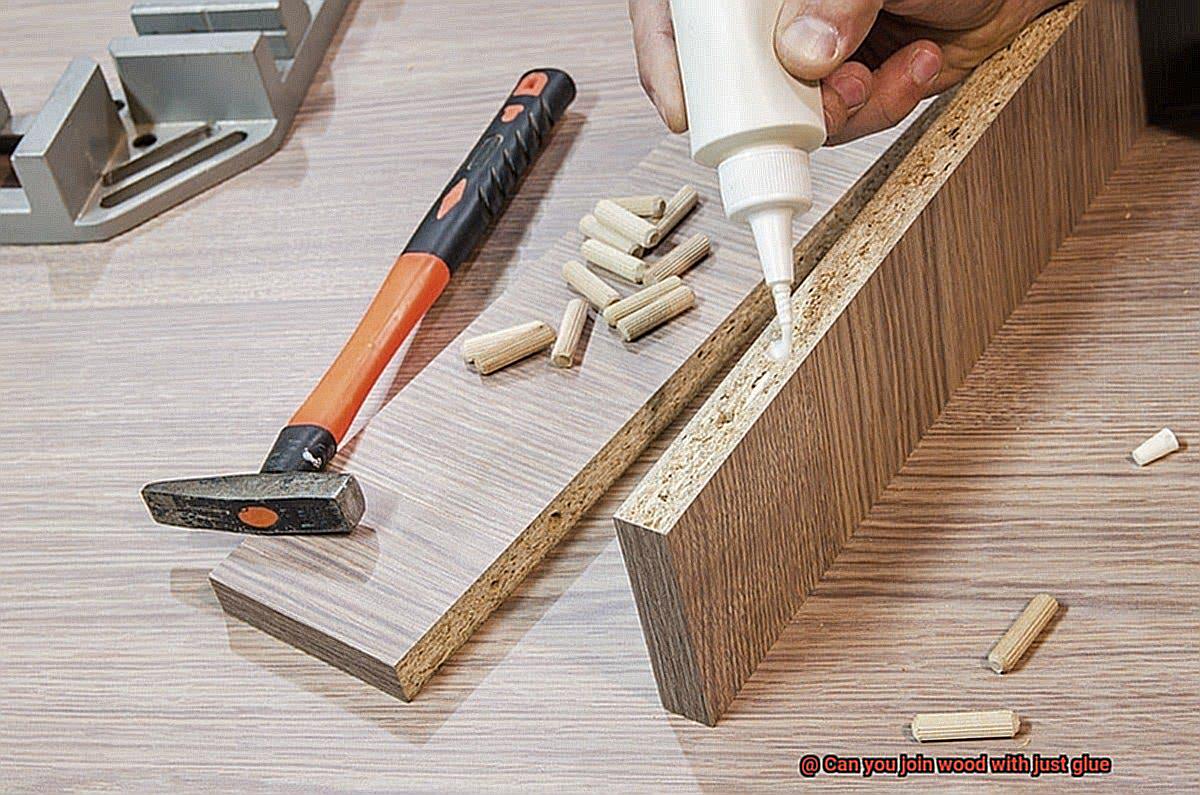
Allow enough drying time
The drying time will depend on the type of glue used and the temperature and humidity of your workspace. Rushing the process can compromise the bond, so follow the manufacturer’s instructions and don’t rush it.
Sand and finish
Once the glue has dried completely, sand any excess glue from the surface and finish as desired.
Common Mistakes to Avoid When Joining Wood with Just Glue
Joining wood with just glue is a fantastic way to create a seamless and polished look in your woodworking projects. However, as an expert on this topic, I’ve seen many common mistakes that people make when gluing wood together, which can result in weak joints and cause the wood to split or break over time. To avoid these issues and ensure your project lasts for years to come, it’s crucial to avoid these common mistakes.
One of the most common mistakes is not applying enough glue. To create a strong bond, it’s essential to apply a sufficient amount of glue to both surfaces. By doing this, the glue can penetrate the wood fibers and create a robust joint. If you don’t apply enough glue, the joint may be weak and prone to failure. So, be generous with the amount of glue you apply.
Another mistake is using the wrong type of glue. There are different types of glue available for woodworking, each with their own strengths and weaknesses. Some glues are better suited for indoor use, while others are designed for outdoor projects. Some glues are also better suited for certain types of wood, such as hardwood or softwood. Using the wrong type of glue can result in a weak bond, so it’s vital to choose the right one for your project.
Proper clamping is also crucial when joining wood with just glue. Clamping the pieces together firmly while the glue dries prevents movement or shifting, ensuring that the joint stays in place and that the glue can fully cure. If you don’t clamp the joint properly, the pieces may shift or move while the glue is drying, resulting in a weak bond.
Finally, not allowing enough drying time can also weaken your joint. Glue needs time to fully cure and create a strong bond. Rushing the process can lead to a weak bond or even breakage. It’s vital to follow the manufacturer’s instructions for drying time and allow plenty of time for the glue to fully cure before using or moving your project.
kYhrrgxZcOI” >
Conclusion
In conclusion, gluing wood together can be a simple and cost-effective solution that yields strong and secure results. However, selecting the right type of glue is crucial for achieving optimal bonding. PVA glue is a versatile and affordable option that is widely used in woodworking for its reliability and strength. Other adhesive options include epoxy, hide glue, cyanoacrylate (super glue), and polyurethane.
When gluing wood together, it’s important to consider various factors such as the type of wood being used, its condition, pressure applied during bonding, and drying time. Softwoods are generally easier to bond with glue while hardwoods may require thin or fast-drying adhesives to penetrate their tight grain before setting. Exotic woods may even necessitate specialized adhesives due to their high oil content.
To ensure a durable bond between pieces of wood using just glue, proper preparation of surfaces is key. Lightly sanding the surfaces creates a rough texture that helps the glue adhere more effectively. Applying an even layer of glue to both surfaces followed by clamping them together while the glue dries evenly distributes pressure across the joint and prevents gaps or weak spots in the bond.
Common mistakes to avoid when joining wood with just glue include not applying enough adhesive, using an inappropriate type of glue for your project, improper clamping during bonding process, and not allowing sufficient drying time which can weaken your joint over time. By avoiding these common pitfalls and following best practices for gluing wood together will result in strong joints that can withstand years of use.
In summary, while gluing wood together may seem like a straightforward task, there are several critical factors to consider when selecting your adhesive and preparing your surfaces for bonding.


